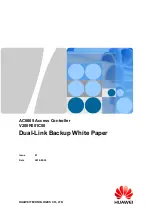
AC6605 Access Controller
Dual-Link Backup White Paper
1
Dual-Link Backup
Issue 01 (2012-05-30)
Huawei Proprietary and Confidential
Copyright © Huawei Technologies Co., Ltd.
3
switchover.
Users that were authenticated using open system or WEP authentication do not
need to go online again.
Figure 1-1
Dual-link backup
AC1
AC2
Aggregation
switch
Access switch
AP
AP
STA
CAPWAP primary link
CAPWAP backup link
Impact of an active/standby switchover on services is as follows:
During an active/standby switchover, services are interrupted for a period because an AP
needs to detect the failure of primary link using CAPWAP heartbeat packets. The service
interruption time is determined by the heartbeat interval (3s to 300s) and number of
detection attempts (2 to 120). Users cannot use Internet services, but they are still online
and do not need to be reauthenticated after the switchover is complete. The AP status on
the standby AC changes from standby to normal after the AP detects a failure on the
primary link.
When traffic is switched back from the standby AC to the active AC, services are not
affected because both the primary link and backup link are working properly. Users are
still online and do not need to be reauthenticated after the switchover is complete.
1.3.2 AP Login Process
After an AP is powered on, it uses DHCP to obtain its own IP address and IP addresses of the
active and standby ACs. The AP then discovers the ACs and establishes primary and backup
links with the ACs to implement dual-link backup.
If neither of the active and standby ACs is used as a DHCP server, you only need to set
Option 43 to IP addresses of the active and standby ACs on the DHCP server and do not need
to consider the IP address lease. The following describes the AP login process when an AC
functions as a DHCP server.









































